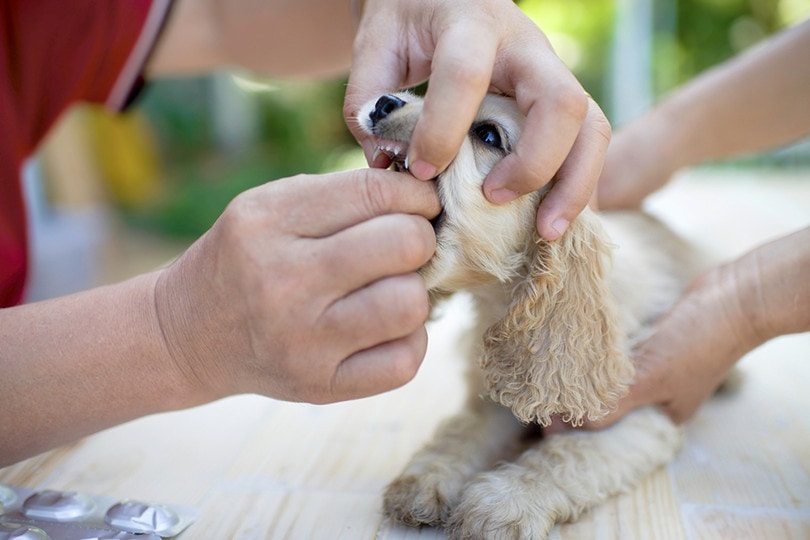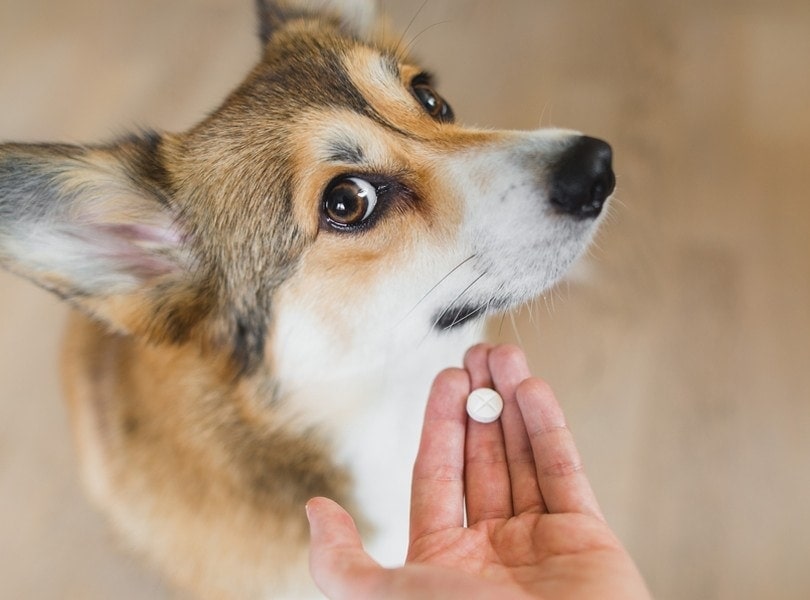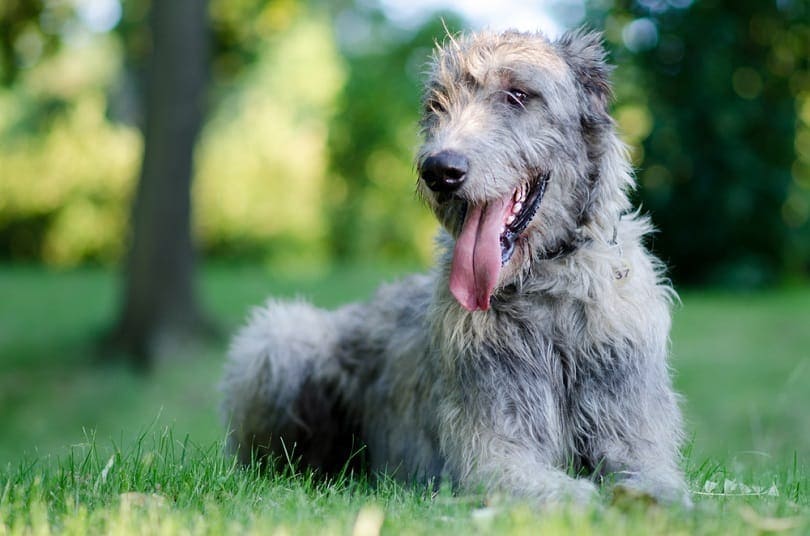Cushing Disease in Dogs: Vet Reviewed Signs, Causes, and Care

Updated on

Cushing’s disease affects dogs just like it can affect humans. It’s one of the most common diseases faced by middle-aged and senior dogs and is often underdiagnosed due to how similar many of the signs are to the normal aging process. The signs of the disease also vary depending on the dog suffering from the condition, which makes diagnosis a challenge.
While Cushing’s disease can affect dogs in different ways, it has the potential to be a life-threatening condition if mismanaged or left untreated. This guide is an overview of Cushing’s disease in dogs and includes the reasons why it’s important to catch it early.
What Is Cushing’s Disease?
Also known as Cushing’s syndrome or hyperadrenocorticism, Cushing’s disease commonly affects dogs more than 8 years old. Due to how varied the signs are among different patients and their slow onset, it’s frequently underdiagnosed but is more common than many people realize. Cushing’s disease also affects humans and cats, albeit to a much lesser extent.
The condition occurs when too much cortisol is produced by the body. Cortisol is also referred to as the stress hormone. It is a natural steroid that the body uses to increase its metabolisms, suppress inflammation, and regulate glucose levels, and blood pressure. It impacts body weight, tissue structure, and skin condition. Too much cortisol — or too little — can severely affect your dog’s organs, put your dog at greater risk of developing serious health conditions, and be life-threatening.
Overproduction of cortisol can be a result of natural causes, such as tumors on the pituitary or adrenal glands. It can also be due to the prolonged use of prescription steroids used for treating other medical conditions that your dog might suffer.

What Are the Signs of Cushing’s Disease?
Part of the reason that Cushing’s Disease is often mistaken for the normal aging process in dogs is how slowly a few of the signs of the disease develop. Not only is the condition usually well underway by the time that it’s correctly diagnosed, but many of the signs are widespread and vary depending on the affected dog. Many are also commonly considered unrelated.
The most common signs of Cushing’s disease are often increased thirst and hunger, but there are many others,including1.
- Hair loss
- Excessive panting
- Lethargy
- Increased appetite, thirst, and urination
- Urinary tract infections
- Bacterial skin infections
- Hard skin on the nose and paw pads
- Enlarged abdomen or potbellied appearance
What Are the Causes of Cushing’s Disease?
Cushing’s disease commonly affects aging dogs, most often when they’re older than 8 years old. There are three types of Cushing’s disease, and each one affects why the condition develops, how it progresses, and the treatment to cure or manage the signs.
Pituitary dependent
About 80–85% of Cushing’s disease cases are pituitary dependent, which means the tumor is located on the pituitary gland at the base of the brain. This gland produces several necessary hormones for the body to function properly; one is the adrenocorticotrophic hormone (ACTH), which stimulates the adrenal glands into making cortisol.
When a dog has Cushing’s disease, the tumor on the pituitary gland causes an overproduction of ACTH, which in turn, increases the amount of cortisol made by the adrenals. Usually, the tumors on the pituitary are benign, but they can cause neurological problems as the condition develops.
Adrenal dependent
Adrenal-dependent Cushing’s disease is less common but similar to pituitary-dependent Cushing’s, it is due to a tumor. However, instead of being on the pituitary gland, the tumor develops in the adrenal glands, which are located next to the kidneys.
While the tumors can be malignant or benign, both stimulate the production of cortisol by the adrenals and lead to excessive circulating amounts. Tumors can often be removed with surgery to cure the condition. Malignant tumors, however, are more likely to result in fatality, especially if the tumor has metastasized by the time that the condition is diagnosed.
Iatrogenic Cushing’s Syndrome
The third type of Cushing’s disease is caused by steroid medication and is known as iatrogenic Cushing’s syndrome. If your dog is given steroids for too long, it can result in similar effects of tumors on the pituitary or adrenal glands. Unlike pituitary- and adrenal-dependent Cushing’s disease, the iatrogenic variation is the only type that can be prevented.
Talk to your veterinarian about the risks associated with prolonged use of steroids, and work with them to develop a plan to prevent it. By limiting your use of steroids to treat health conditions that your dog might suffer from, you can help reduce the risk of them developing iatrogenic Cushing’s disease.

How Do I Care for a Dog With Cushing’s Disease?
Treatment depends on the type of Cushing’s disease that your dog develops. Although it can be difficult to catch it early, the earlier that it’s diagnosed, the better you can manage the signs and successfully treat your dog.
Pituitary tumors are often the most complex form of the disease. This variation is most commonly treated with the drugs trilostane and mitotane.
Adrenal tumors are treated with a complicated abdominal surgery that removes the tumor. Provided that the tumor is benign and is removed completely, the condition can be cured.
Iatrogenic Cushing’s disease is treated by discontinuing the steroid medication that your dog is using. It’s a slow process that involves weaning your dog off its medication and often results in the original disease being treated by the steroids reoccurring.
Beyond treatment, Cushing’s disease requires you to carefully monitor your dog’s signs and progress. It can be a complicated disease to manage but with help from your veterinarian — and a few treatment readjustments, your dog can enjoy a good life quality. Along with the treatment for the type of Cushing’s disease that your dog has, you can also help to manage their signs by adjusting how you feed or medicate your dog.
Manage Their Diet
The nutritional content of your dog’s meals can go a long way in helping ease certain signs caused by the overproduction of cortisol. It’ll take a while to ensure that their diet has the right balance of nutrients, but with a bit of work, their food can help them.
If they’re suffering from Cushing’s disease, your dog will need a diet that is adjusted to match their signs and how the disease is affecting them. Your veterinarian can help work out the nuances of the food that they need, but here are a few common foods for dogs with this disease:
- Formulated for adult dogs
- Low in fat, sodium, and chloride
- Contains moderate fiber and highly digestible protein
Don’t Restrict Water
One of the most common signs of Cushing’s disease is increased thirst. Since this often leads to more frequent potty breaks, it can be tempting to gently “encourage” your dog to drink less by withholding their water. This is never the right course of action.
While it can be frustrating to have to constantly fill up water bowls and head outside for potty breaks, the best solution for your dog is to manage the disease properly. The better you control the cortisol levels and signs, the more likely they will drink normal amounts and need fewer pee breaks.
Reduce Steroid Usage
If your dog is suffering from iatrogenic Cushing’s disease, gradually reducing the steroid medication that caused it is the only way to treat it. You must follow your veterinarian’s directions when it comes to weaning your dog off its medication and be prepared for its original illness to return.

Is My Dog’s Excessive Licking a Sign of Cushing’s Disease?
Although excessive licking isn’t considered a specific sign of Cushing’s disease, it can be a result of a few of the signs that the disease causes. Excessive licking can be a result of skin infections or itchy, irritated skin caused by Cushing’s. A urinary tract infection can also lead to your dog paying more attention to its rear end than usual due to discomfort.
Excessive licking doesn’t just indicate Cushing’s disease, though. It’s a good idea to get your dog diagnosed by a veterinarian to rule out anxiety-related issues, injuries, dental problems, and disorders like OCD.
Frequently Asked Questions (FAQ)
How Long Does a Dog With Cushing’s Disease Live?
Since Cushing’s disease most commonly affects senior dogs, it can be difficult to know for sure how long dogs can live with the disease; 2 years is the average lifespan of many dogs with Cushing’s disease, though many of the dogs suffering from the disease die from unrelated causes.
Although Cushing’s can cause severe health problems in dogs, such as kidney issues, it’s not always fatal, especially when it’s caught early and properly managed. It depends on how you manage the disease, how old your dog is, and if they have any other health issues.
What Dog Breeds Are More Prone to Cushing’s Disease?
Like most health issues in dogs, some breeds are more prone to developing Cushing’s disease than others. This doesn’t mean that another breed won’t develop the problem or that these breeds will always suffer from the issue. However, the possibility is heightened if the breed is already predisposed to developing the condition.
Conclusion
Despite being underdiagnosed, Cushing’s disease is one of the most common conditions that can affect aging dogs. Many of the signs are often considered to be normal for senior dogs, and since most of them develop slowly over time, they can be easily missed. Unfortunately, late diagnosis can make treatment and management trickier and increase the risk of your dog developing more serious health problems.
Featured Image Credit to: Nick Kuppens, Shutterstock













